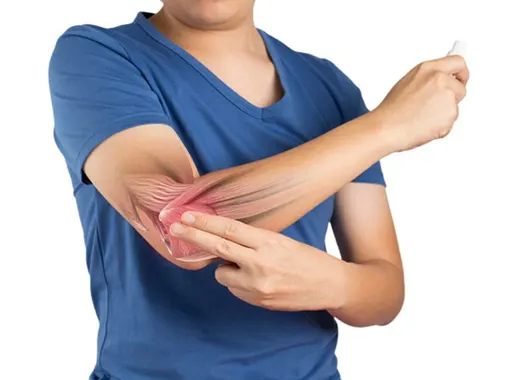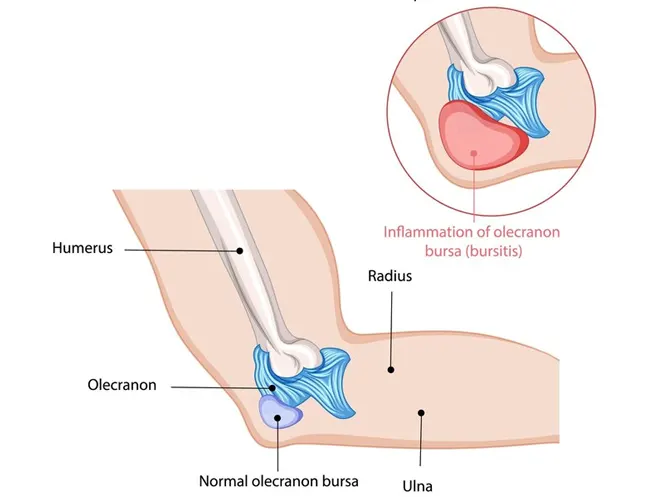
Complete Elbow Replacement (CAR)
Elbow replacement is surgery to replace the bones of the elbow joint with artificial joint parts (prosthetics). In this surgery, an artificial elbow joint consisting of 2 stems made of high-quality metal are used. These 2 stems are then joined together with the help of a metal and plastic hinge, which allows the artificial joint to bend just like a natural elbow joint, and helps the affected person to again resume the free movement of arms without any considerable amount of pain or trouble.
A complete Elbow Replacement (also termed as elbow Arthroplasty) can efficiently take care of the problems caused by arthritis of the elbow. This procedure is said to have a very high rate of success among patients. According to the latest data figures available in India, it is understood that more than 90 percent of patients who have undergone a complete elbow joint replacement procedure have had lasting relief after the operation.
Anatomy of an elbow joint…
Made up of 3 bones, humerus (bone of the upper arm), ulna and radius (bones of the forearm), the elbow joint forms a hinge which allows the arm to uncurl and curl back from its position during movement of the arms. The large triceps muscles located in the rear of arm with ulna, contract and loosen out to enable the back and forth movement of the elbow. The biceps muscles located in front of the arm contract to enable the bending of elbow.

What makes elbow joint replacement surgery necessary?
A complete Elbow Replacement surgery is generally adopted as the final alternative for a roughly broken and sore elbow joint. The synthetic joint takes place of the broken surfaces with metal and plastic components that are intended to fit jointly and rub effortlessly against each other. This takes away the soreness of bone friction against bone.
The most widespread cause for a complete Elbow Replacement is arthritis. There are mainly 2 kinds of arthritis, degenerative and systemic. Degenerative arthritis is also called wear-and-tear arthritis, or osteoarthritis. Any injury to the elbow can damage the joint and lead to degenerative arthritis. This Arthritis may not show up for many years after the injury.
There are several kinds of systemic arthritis. The most common form is rheumatoid arthritis. All types of systemic arthritis are diseases that affect many, or even all, of the joints in the body. Systemic arthritis causes destruction of the joints' articular cartilage lining.
A complete Elbow Replacement surgery may also be used immediately following certain types of elbow fractures, usually in aging adults. Elbow fractures are difficult to repair surgically in the best of circumstances. In many aging adults, the bone is also weak from osteoporosis. (People with osteoporosis have bones that are less dense than they should be.) The weakened bone makes it much harder for the surgeon to use metal plates and screws to hold the fractured pieces of bone in place long enough for them to heal together. In cases like this, it is sometimes better to remove the fractured pieces & replace the elbow with an artificial joint.
The Artificial Elbow:
There is more than one type of artificial elbow joint (also called prosthesis). The most common types are like a hinge. The prosthesis has 2 parts. The humeral component replaces the lower end of the humerus in the upper arm. The humeral component has a long stem that anchors it into the hollow center of the humerus. The ulnar component replaces the upper end of the ulna in the lower arm. The ulnar component has a shorter metal stem that anchors it into the hollow center of the ulna.
The hinge between the 2 components is made of metal and plastic. The plastic part of the hinge is tough and slick. It allows the two pieces of the new joint to glide easily against each other as you move your elbow. The hinge allows the elbow to bend and straighten smoothly.
There are 2 different methods to clutch the artificial elbow in its position. A cemented prosthesis uses a special type of epoxy cement to glue it to the bone. An uncemented prosthesis has a fine mesh of holes on the surface. Over time, the bone grows into the mesh, anchoring the prosthesis to the bone.
The Operation…

A good number of complete Elbow Replacement surgeries are primarily undertaken under general anesthesia. General anesthesia puts you to sleep. In some cases surgery is done with regional anesthesia, which deadens only the nerves of the arm. If you use regional anesthesia, you may also get medications to help you drift off to sleep, so you are not aware of the surgery.
After the anesthesia, the surgeon makes an incision in the back of the elbow joint. The incision is made on the back side because most of the blood vessels and nerves are on the inside of the elbow. Entering from the back side helps prevent damage to them.
The tendons and ligaments are then moved out of the way. Care must be taken to move the ulnar nerve, which runs along the elbow to the hand. Once the joint is exposed, the first step is to remove the joint surfaces of the ulna and the radius. This is usually done with a surgical saw. The surgeon then uses a special rasp to hollow out the marrow space within the ulna to hold the metal stem of the ulnar component. The ulnar component is then inserted into the bone to test the fit. If necessary, the surgeon will use the rasp to reshape the hole in ulna.
When the ulnar component has been fitted correctly, the surgeon repeats the procedure on the humerus. After the humeral component has been fitted, the surgeon puts together the pieces of the implant and checks to see if the hinge is working correctly. The implant is then removed, and the bone is prepared to cement it in place. The pieces are cemented in place and put together. After another check for proper fit and motion, the surgeon sews up the incision.
After surgery, your elbow will probably be covered by a bulky bandage and a splint. Depending on the type of implant used, your elbow will either be positioned straight or slightly bent. You may also have a small plastic tube that drains blood from the joint. Draining prevents excessive swelling from the blood (This swelling is sometimes called a hematoma). The draining tube will probably be removed within the first day. Assisted elbow movements are started by an occupational or physical therapist the day after surgery.
